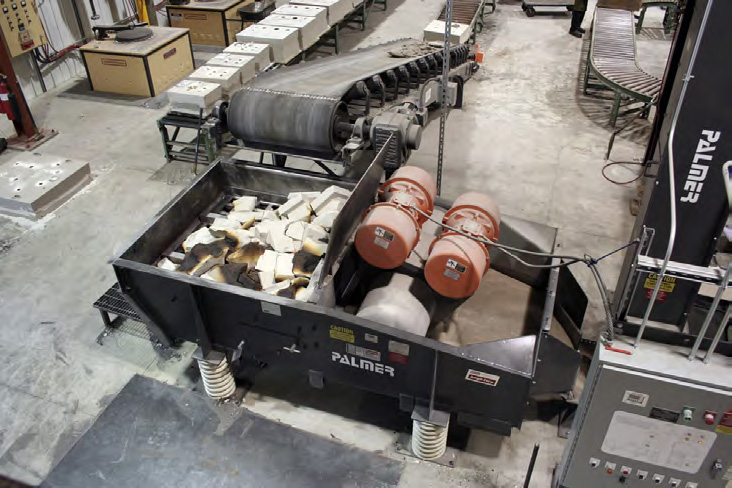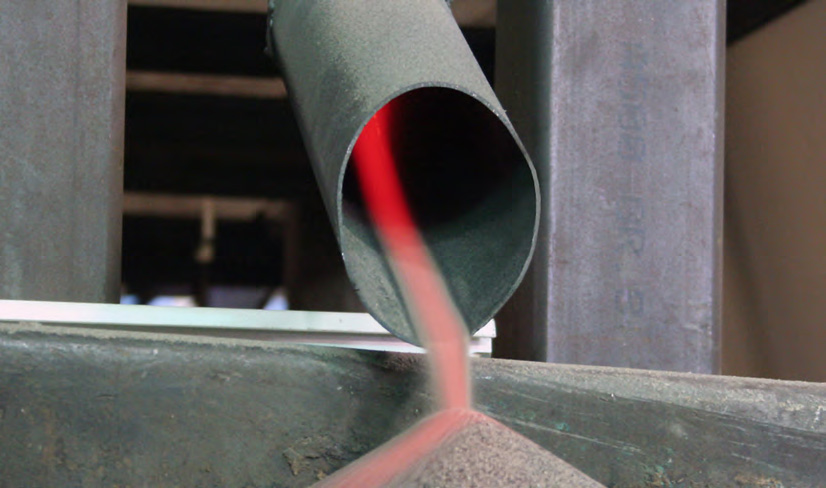Foundry & industrial processing Machinery EQUIPMENT & SYSTEMS
U.S. & Canada Call 1.800.457.5456
Sand Reclamation Basics
Home Articles Sand Reclamation Basics

Simple Solutions That Work!™, Volume 12, April 2020
Written - Jack Palmer
Jack Palmer
President
Palmer Manufacturing & Supply, Inc.
Article Takeaways:
WHAT IS SAND RECLAMATION?
Sand Reclamation is the physical, chemical, or thermal treatment of used foundry casting sands so that they can safely and effectively be re-used for molding and coremaking applications.
WHY BOTHER WITH SAND RECLAMATION?
Acquisition Costs
For many years, sand was cheap and readily available for foundry applications. Over time, we have seen the costs of sand grow due to increased mining costs, increased transportation costs, increased Quality Assurance costs, Alternative Higher Profit Applications (such as Frac Sand), etc.
Sand reclamation will allow re-use of sand, which reduces the amount of new virgin sand which must be sourced in order to maintain production.
Disposal Costs
For many years, most cities, counties, and even many foundries had their own landfills where spent sand could be disposed of. Over time, there have been many changes in regards to safety regulations, health codes, etc that have greatly reduced the number of disposal facilities and increased the disposal regulations. With this comes a much higher cost for disposal.
Sand reclamation will allow re-use of sand, which reduces the amount of used sand which must be disposed of.
Environmental Responsibility
Less new sand usage helps to maintain Earth’s resources. More sand re-use reduces waste.
It’s just the right thing to do, both financially and environmentally.
Silica Exposure Limits and Synthetic Sands
With the current silica rules and the inability of some foundries to meet the exposure limits, one of the solutions pursued by some is to completely remove silica from their facility and switch over to a synthetic sand. With costs of synthetic sand being in the range of 10+ times higher than standard silica sand, it will make reclamation significantly more important in order to remain profitable with increased material costs.
SAND RECLAMATION SYSTEMS
There are 2 major types of sand reclamation systems:
- Mechanical
- Thermal
A mechanical reclamation system uses motion energy to physically break down chunks of spent casting sand into a clean, usable, grain size sand.
A thermal reclamation system takes sand that has been broken down to grain size in a mechanical reclamation system and adds heat energy in order to burn the remaining resins off the sand.
In most cases, a mechanical reclamation system is a requirement before a thermal reclamation system can be added. Historically, most foundries go through the evolution of:
- No reclamation – all spent sand is thrown out
- Add a Mechanical Reclamation System and become skilled at using it
- Later add a Thermal Reclamation System to further expand the savings
There are a smaller percentage of foundries who will add an entire new molding line and will include new mechanical and thermal reclamation systems from the start.
Mechanical Reclamation System
A typical mechanical reclamation system will include the following sequence of components:
- Shakeout Deck
- Attrition Mill
- Elevating Device
- Surge Hopper
- Magnetic Separator
- Agglomerate Screener
- Fluid Bed Classifier (Cooling Optional)
- Elevating or Pneumatic Transportation Device
- Bulk Storage Silo for Mechanically Reclaimed Sand
- Dust Collector

Thermal Reclamation System
A typical thermal reclamation system will include the following sequence of components:
- Surge Hopper for Supply
- Magnetic Separator (if not already included upstream)
- Metered Feed Mechanism
- Heating Zone
- Cooling Zone
- Elevating or Pneumatic Transportation Device
- Bulk Storage Silo for Thermally Reclaimed Sand
- Dust Collector (likely high temperature)
If a Thermal Reclamation System is being included, there are different schools of thought by foundries as to sizing and usage. Some foundries will thermally reclaim all sand. Others will only thermally reclaim a portion of their sand and will then blend it into the system in order to control their LOI readings. This choice will also affect the total lists of equipment components to included in a typical system, and will affect exactly where the sand stream exits the mechanical reclaimer and enters the thermal reclaimer
Benefits of Thermally Reclaiming ALL Sand:
- All sand going into the mold is consistent
- No concerns about LOI
- The equipment for mixing, storage, and sand transportation are generally simpler as there is not a need to have daytanks for both mechanically and thermally reclaimed sand above the mixer
- The operator simply feeds a single sand into all molds rather than having to switch from new to mechanically reclaimed at a specified point in the mold
Disadvantages:
- The Thermal Reclaimer will need to be larger in order to process all sand
Benefits of Thermally Reclaiming only a portion of Mechanically Reclaimed Sand:
- The Thermal Reclaimer will be a smaller size than if processing ALL sand
- Reduced electric/LP/Natural Gas costs
Disadvantages:
- The operator will be left to choose the point at which the facing new sand becomes a backing mechanically reclaimed sand – This equates to variability in the blend ratio
- Blend ratio variability leads to tighter controls and monitoring required on LOI
- The equipment is more complex as dual daytanks and slidegates, separate transporters, separate storage silos, etc are required

Thermal Reclamation System Types
- Electric – For small applications up to around 600 pounds per hour, which is roughly equal to a truckload of sand per week
- Gas-fired – For larger applications
- Typically either a fluid bed style or a rotating calciner
Mechanical Reclamation System Offerings
A basic mechanical system includes:
- Shakeout Deck / Attrition Mill Combination Unit
- Bucket Elevator
- Surge Silo/Hopper (suggested)
- Classifier without cooling
- Control Panel for All Above Items
A basic mechanical reclamation system is a good choice for foundries who:
- Shakeout when sand is 250°F or lower
- Have throughput requirements not exceeding 6-8 TPH depending on resin system, metal poured, sand:metal ratio, etc.
- Do not need to cool their sand prior to leaving the reclamation system
- Have few, if any, chills in their molds
Shakeout Deck Attrition Mill Combination units are available in deck sizes of 3’, 4’, 5’, 6’, and 7’ square. Generally, the maximum mold should be at least 1’ smaller than the size of the deck.
Optional Upgrades to basic mechanical systems:
- Magnetic Separation
- Additional Agglomerate Screeners
- Upgrade to a Cooler Classifier to allow sand to be cooled
- High Temperature Air Driven Elevators to allow for sand temps above 300-400°F
After the classifier, the sand will generally need directed to a different silo for bulk storage, or back to a daytank for point of use storage. In either case, as there is generally horizontal distance between the classifier and this storage location, a pneumatic transporter is an excellent way to move the sand to its destination.
There are times when a foundry may need a system that has more capability than a basic system. Some examples may be:
- Large throughput amounts or very large molds
- High temperature of shakeout
- The desire for automatic chill removal from the sand stream
- Fragile castings that require a modulated shakeout
In these cases, it is very common to change from a shakeout deck/ attrition mill combination unit over to a system that has separate pieces of equipment for shakeout and attrition, as well as often having vibratory lift devices to elevate chunks of sand.
As always, it is best to work with your supplier giving a full scope of the reclamation work that needs to be done, including both the odd size pieces, as well as the bulk sizes that cover 90% of your production. With this information, a system can be designed that will meet the environmental desires, the simplicity of use, and the financial savings that help to make sand reclamation the right choice.
Copyright © 2025 Palmer Manufacturing & Supply, Inc. | Terms and Conditions | Privacy Policy




